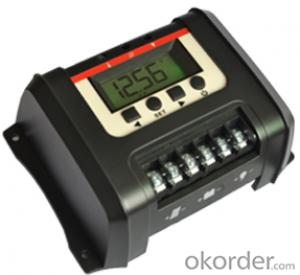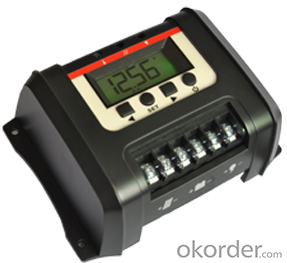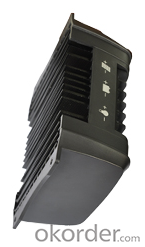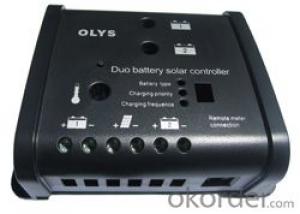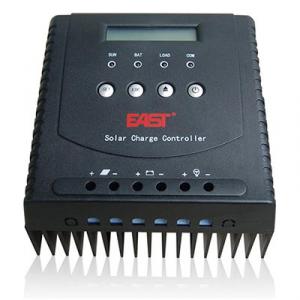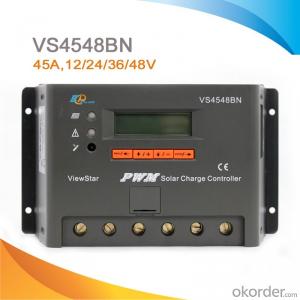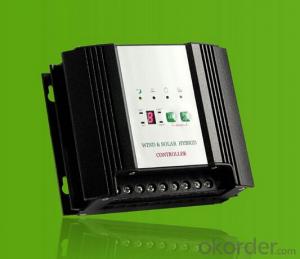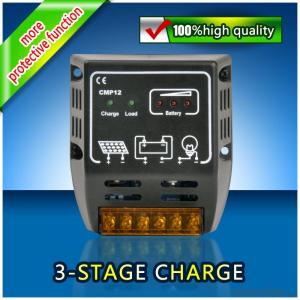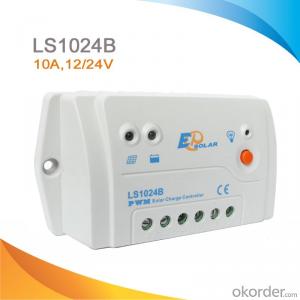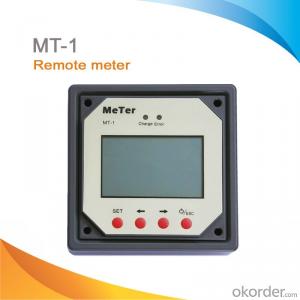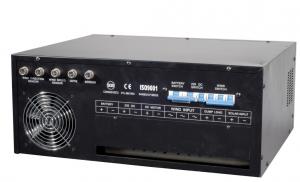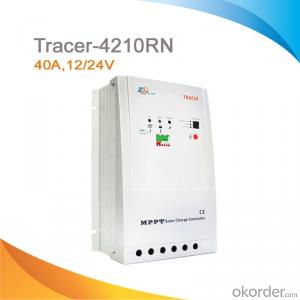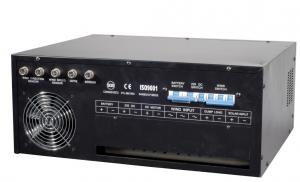Xw Solar Charge Controllers with LCD Display
- Loading Port:
- Shekou
- Payment Terms:
- TT OR LC
- Min Order Qty:
- 50 unit
- Supply Capability:
- 100000 unit/month
OKorder Service Pledge
OKorder Financial Service
You Might Also Like
1. The charge controller automatically recognize 12V or 24V system.
2. Mainly suitable for small off-grid solar power system, for example: home solar power systems, ships, self-service base stations, outposts, etc.
3. LCD display various parameters of charge and discharge.
4. Boost charge voltage and battery low voltage protection point can be adjustable 5. The three-stage PWM charging mode
6. Load output can be manually controlled。
7. With high-precision temperature compensation function.
8. With electronic protection
Technical Data
| MODEL | SNC10 SNC20 SNC30 SNC40 |
| Max.solar panel current | 10A 20A 30A 40A |
| Max. load current | 10A 20A 30A 40A |
| NO-load current | 10MA |
| Overvoltage protection | 15.5V(12V), 31V/24V; |
| Work temperature range: | -35℃--+55℃ |
| Boost voltage | 14.6V(12V), 29.2V/(24V) |
| Equalization voltage | 14.8V(12V), 29.6/(24V) |
Float voltage | 13.8V(12V), 27.6V/(24V) |
Recharge voltage | 13.2V(12V); 26.4/(24V); |
Temperature compensation | -5mv/℃/2V |
Low-voltage disconnect | 11V(12V); 22/24V; |
Load reconnect voltage | 12.6V(12V), 25.2/24V |
Charge control mode | PWM |
diplay mode | LCD |
- Q: Can a solar controller be used with different types of solar panel voltage regulators?
- Yes, a solar controller can be used with different types of solar panel voltage regulators. The purpose of a solar controller is to regulate and control the charging process of a solar panel system, regardless of the type of voltage regulator being used. As long as the solar controller is compatible with the voltage range and specifications of the solar panel voltage regulator, it can be effectively used to optimize the charging and protect the batteries in the system.
- Q: Can a solar controller be used with solar panels that are connected to a battery backup system?
- Yes, a solar controller can be used with solar panels that are connected to a battery backup system. In fact, a solar controller is typically an essential component of such a system. The main function of a solar controller is to regulate the voltage and current from the solar panels to prevent overcharging of the batteries. It does this by monitoring the battery state of charge and adjusting the charging parameters accordingly. When solar panels are connected to a battery backup system, the solar controller ensures that the batteries are charged efficiently and effectively. It controls the flow of electricity from the solar panels to the batteries, maximizing the charging capacity and optimizing the battery life. Additionally, a solar controller can also provide other important functions such as load control, which controls the power consumption from the batteries, and system monitoring, which provides real-time information on the performance of the solar panels and batteries. Overall, a solar controller is an essential component in a solar panel system connected to a battery backup system, ensuring proper charging and management of the batteries, and improving the overall efficiency and performance of the system.
- Q: What are the key features to consider when purchasing a solar controller?
- When purchasing a solar controller, some key features to consider include the controller's maximum voltage and current capacity, as it should be able to handle the power generated by your solar panels. Additionally, the controller should have a suitable charging algorithm to optimize battery charging and prevent overcharging. Other important features include temperature compensation to ensure efficient performance in varying weather conditions, display and monitoring options for easy operation and system troubleshooting, as well as built-in protection mechanisms like reverse polarity and short circuit protection. Ultimately, the choice should also depend on the specific requirements of your solar power system.
- Q: Can a solar controller be used with a solar-powered landfill gas extraction system?
- Yes, a solar controller can be used with a solar-powered landfill gas extraction system. The solar controller helps regulate and optimize the charging and discharging of the batteries used to store the solar energy generated by the system. It ensures that the extracted landfill gas is efficiently converted into electricity while maintaining the battery life and system performance.
- Q: What are the advantages of using a solar controller in a solar system?
- Utilizing a solar controller in a solar system offers multiple benefits: 1. Energy management efficiency: The inclusion of a solar controller allows for effective management of the energy generated by the solar panels. It regulates the electricity flow from the panels to the battery or grid, ensuring optimal system efficiency. 2. Battery safeguarding: Solar controllers prevent battery overcharging and deep discharging. By monitoring battery voltage and current, they ensure optimal charging and protection against damage, extending battery lifespan. 3. System security: Solar controllers safeguard the system against potential electrical faults, such as overvoltage or short circuits, which can harm the panels or other components. This guarantees the overall safety of the solar system. 4. Improved performance in diverse weather conditions: Solar controllers possess built-in features that enable them to adjust charging parameters based on weather conditions. This maximizes solar panel energy output, even in cloudy or low-light conditions. 5. Remote monitoring and control: Many solar controllers offer advanced features like remote monitoring and control. This allows users to conveniently monitor system performance and make necessary adjustments remotely, providing flexibility. 6. Cost-effectiveness: By optimizing the charging process and preventing battery damage, solar controllers reduce maintenance and replacement costs. Additionally, they maximize energy output, resulting in significant savings on electricity bills. In summary, incorporating a solar controller into a solar system yields numerous advantages, including efficient energy management, battery protection, system security, improved performance in diverse weather conditions, remote monitoring and control, and cost-effectiveness.
- Q: How does a solar controller handle short circuit protection?
- The safety and functionality of a solar system are ensured by a solar controller through various mechanisms and features that handle short circuit protection. To begin with, constant monitoring of the current flowing through the system is carried out by a solar controller equipped with built-in electronic circuitry. If the current exceeds the rated capacity of the controller, indicating a short circuit, the excessive current flow is immediately detected. Once the detection of a short circuit occurs, the solar controller employs different protective measures to prevent damage to the system. One of the main protections involves the use of fuses or circuit breakers strategically placed within the circuit. These devices interrupt the current flow when a short circuit occurs. Fuses are designed to melt and break the circuit if the current exceeds their rated capacity, while circuit breakers achieve the same task using an electromechanical mechanism. Additionally, advanced microprocessors and monitoring systems are commonly utilized in modern solar controllers. These systems can detect irregularities in the current flow and promptly shut down the system to prevent potential damage. They also provide real-time monitoring and diagnostics, aiding in the identification and resolution of any issues before they escalate. Furthermore, temperature sensors are often incorporated into solar controllers as additional protective features. These sensors detect any abnormal increase in temperature, which may indicate a short circuit or other system issues. Upon detecting excessive temperature, the solar controller can automatically shut down the system to prevent further damage. In summary, short circuit protection in a solar controller involves a multi-layered approach that combines electronic circuitry, fuses or circuit breakers, advanced microprocessors, and temperature sensors. These features work together to detect and mitigate short circuit events, ensuring the safety and longevity of the solar system.
- Q: Are there any safety features in solar controllers?
- Yes, there are several safety features in solar controllers. Some common safety features include overcharge protection, over-discharge protection, short-circuit protection, reverse polarity protection, and temperature compensation. These features ensure the safe and efficient operation of solar controllers and help protect the connected batteries and solar panels from damage.
- Q: How does a solar controller handle battery low voltage recovery?
- A solar controller handles battery low voltage recovery by monitoring the battery voltage levels and automatically initiating a recharging process when it detects that the voltage has dropped below a predefined threshold. This ensures that the battery is constantly maintained at an optimal charge level and prevents over-discharging, which can damage the battery. The solar controller regulates the charging process, gradually increasing the voltage and current supplied to the battery until it reaches the desired charge level, thus facilitating the recovery of the battery's low voltage.
- Q: Can a solar controller handle power surges from the generator?
- Yes, a solar controller can handle power surges from the generator. Solar controllers are designed to regulate and control the flow of electricity from the solar panels to the batteries or grid. They typically have built-in protection mechanisms, such as surge protection devices, to handle power surges and prevent damage to the system.
- Q: Are there any safety precautions I should take when installing a solar controller?
- Yes, there are a few safety precautions you should take when installing a solar controller. First, ensure that the power supply to the controller is switched off before starting the installation process to avoid any electrical shocks. Additionally, it is important to follow the manufacturer's instructions and guidelines carefully to ensure proper installation and avoid any potential hazards. It is also recommended to use appropriate personal protective equipment, such as gloves and safety glasses, to protect yourself during the installation process. Lastly, if you are unsure about any aspect of the installation, it is always best to consult with a professional or seek advice from an experienced individual in the field.
Send your message to us
Xw Solar Charge Controllers with LCD Display
- Loading Port:
- Shekou
- Payment Terms:
- TT OR LC
- Min Order Qty:
- 50 unit
- Supply Capability:
- 100000 unit/month
OKorder Service Pledge
OKorder Financial Service
Similar products
Hot products
Hot Searches
Related keywords
